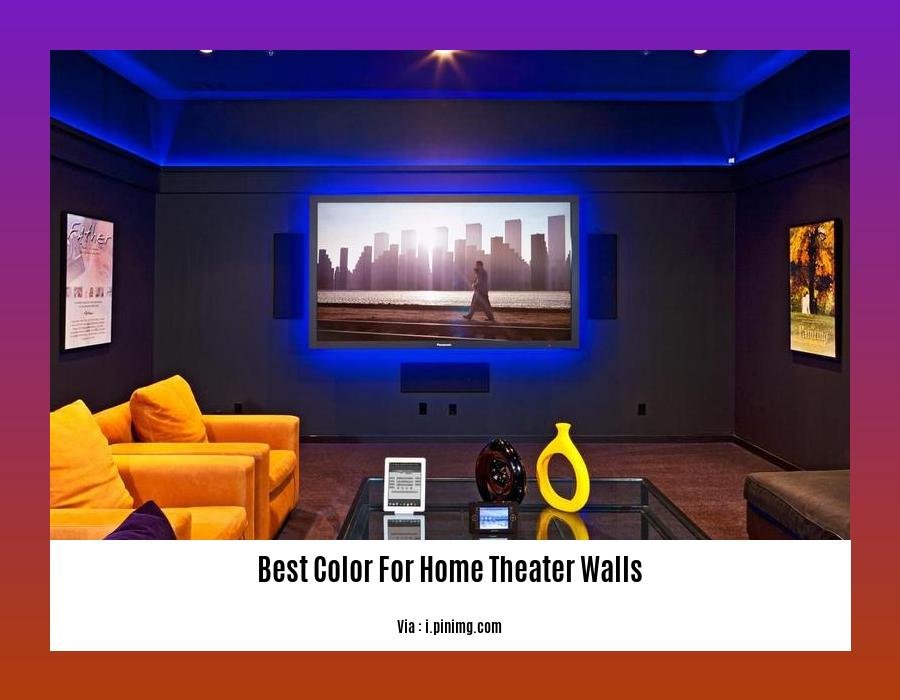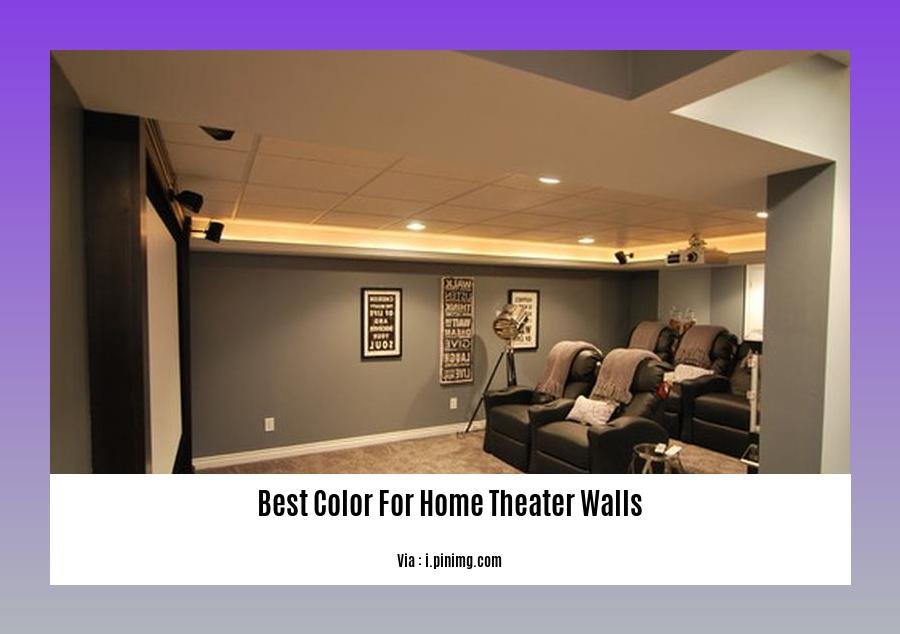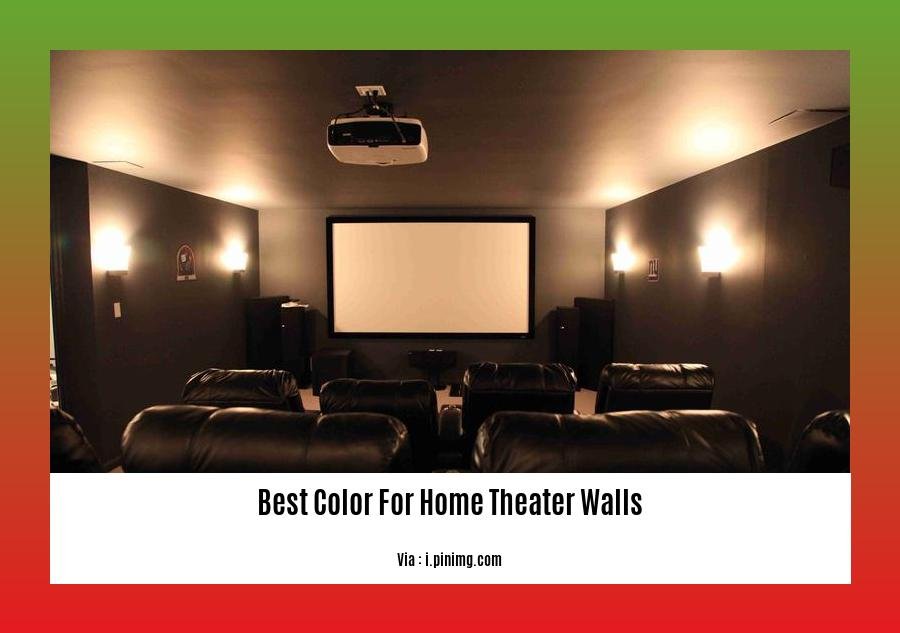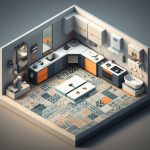Discover the Secrets to Creating an Immersive Cinematic Experience from the Comfort of Your Home: [- The Best Color for Home Theater Walls: Creating Immersive Viewing Environments].
Key Takeaways:
- For a more immersive experience, opt for deep and dark colors on home theater walls.
- Consider colors like navy blue, dark red, and deep green.
- A dramatic effect can be created by incorporating dark, saturated colors onto one wall.
- Avoid white or light colors as they might not give the best experience.
- Black is the ideal color choice for a professional cinema feel.
- Choose dark shades like black, brown, gray, burgundy, or dark red for home theaters.
- Avoid screens with blue tones when using white walls to prevent an unpleasant appearance.
- Select paint colors based on your budget, personal preferences, and the type of space.
- Select flat black for the wall where the screen is mounted to enhance the viewing experience.
- Consider Sherwin-Williams Tricorn Black (6258) for the best black paint in home theater rooms.
Best Color for Home Theater Walls

When designing a home theater, selecting the best color for home theater walls is crucial for creating an immersive and captivating viewing experience. Certain colors can enhance the visual quality, optimize ambiance, and minimize distractions, while others may hinder the overall cinematic effect.
Dark and Rich:
When it comes to home theater walls, dark, rich colors take the spotlight. These colors absorb light, reducing reflections and creating a cozy, intimate atmosphere that envelops viewers in the on-screen action. Deep reds, dark greens, and navy blues are popular choices, exuding a luxurious and cinematic vibe.
Accent Walls:
Adding drama and visual interest to your home theater is as easy as painting one accent wall in a deep, saturated color. This creates a focal point that draws the eye and adds depth to the space. Whether it’s a bold red, a luxurious emerald green, or a deep chocolate brown, an accent wall can transform your home theater into an elegant and inviting sanctuary.
Avoid Light Colors:
White and other light colors are not ideal for home theater walls. They reflect light, which can create glare and wash out the colors on the screen, diminishing the viewing experience. These colors also tend to make the room feel larger and less intimate, which is undesirable for a home theater setting.
Black for a Cinematic Experience:
If you’re aiming for the ultimate cinematic experience, black is the color of choice. Its ability to absorb light completely eliminates reflections and provides the deepest contrast levels, resulting in stunning picture quality. Black also creates a sense of immersion, making viewers feel like they’re right in the middle of the action.
Budget-Friendly Options:
Creating a captivating home theater doesn’t have to break the bank. There are plenty of budget-friendly paint options available that can transform your space without compromising style or functionality. Explore a wide range of dark, rich colors at affordable prices and find the perfect shade that suits your preferences and budget.
Optimized Viewing Experience:
When selecting a color for your home theater walls, consider the type of content you’ll be watching. For movies and TV shows, darker colors are recommended as they enhance the picture quality and create a more immersive experience. However, if you’re planning on using the space for gaming or presentations, you may want to opt for a slightly lighter shade to ensure clarity and visibility.
The Right Black:
Choosing the right black paint for your home theater is essential. Look for a flat black paint with a low sheen to minimize reflections. Sherwin-Williams Tricorn Black (6258) is often regarded as the best black paint for home theater rooms due to its intense and light-absorbing properties. Its deep, rich black creates the perfect backdrop for an immersive viewing experience.
-
Looking for a reliable way to store your car at home? Discover the best car storage lifts that maximize space and convenience in your garage. Best car storage lifts for home garage.
-
Exploring the best elderly home care services in Bangalore? Find a list of trusted providers that offer compassionate and professional care for your loved ones. Best elderly home care services in Bangalore.
-
Arm wrestling enthusiasts, elevate your training with the best exercises you can do at home. Build strength, technique, and endurance with these effective routines. Best exercise for arm wrestling at home.
Design Considerations for a Captivating Ambiance: Color Choices that Enhance the Overall Aesthetics and Atmosphere of the Home Theater

Who says a home theater has to be dark and dreary? With a little thought and planning, you can create a home theater that’s as welcoming and inviting as it is immersive. One of the most important elements of a home theater design is the color of the walls. The right color can help to create a sense of intimacy and coziness, while also providing a backdrop that won’t distract from the movie or TV show you’re watching.
Key Takeaways:
- Color has a huge impact on the overall ambience of your home theater. Consider the type of atmosphere you want to create before selecting a color.
- Dark colors can make a home theater feel more intimate and cozy. They absorb light, which helps to minimize reflections and create a more immersive viewing experience.
- Light colors can make a home theater feel more spacious and airy. They reflect light, which helps to brighten the room and make it feel more inviting.
- Neutral colors are a safe choice for a home theater. They won’t overwhelm the space or compete with the movie or TV show you’re watching.
- Consider the type of content you’ll be watching when selecting a color for your home theater walls. If you’ll be watching mostly movies and TV shows, a dark color is a good choice. If you’ll be gaming or giving presentations, a lighter color might be a better option.
Colors impact moods and emotions. Take some time to consider the mood you hope to create in your home theater. A warm, inviting color, like red or orange, can create a sense of intimacy. While a cooler color, like blue or green, can create a sense of relaxation.
Think about the size of your home theater. A dark color can make a small room feel even smaller. If you have a small home theater, consider a light color or a color scheme that uses a variety of light and dark colors.
Consider the amount of natural light in your home theater. If you have a lot of natural light, you can get away with a darker color. If you don’t have a lot of natural light, you’ll want a lighter color.
Color can enhance your home theater experience. By selecting the right color, you can create a home theater that’s both visually appealing and immersive. So take some time to consider your options and choose the color that’s right for you.
References:
Color Psychology in Interior Design
The Impact of Color on Mood and Behavior
Avoiding Common Color Pitfalls: Discussing colors to steer clear of and the reasons behind their unsuitability.
When designing your home theater, choosing the right color for the walls can significantly impact the overall viewing experience. While personal preference plays a crucial role, certain colors are best avoided to ensure optimal visual performance and a comfortable ambiance. Let’s delve into the colors to steer clear of and the reasons behind their unsuitability:
Bright, Vibrant Colors
-
Highly Saturated Hues: Extremely saturated colors, such as neon greens, electric blues, and fiery reds, can be visually overwhelming and distracting. These shades draw attention to the walls rather than the screen, diminishing the immersive experience.
-
Color Clash: Using multiple bright colors can create a chaotic and disorienting environment. Visual clutter can strain the eyes and make it difficult to focus on the content being displayed.
Light, Reflective Colors
-
White and Pastel Colors: While white may seem like a safe choice, it’s highly reflective, causing glare and washing out the projected image. Pastel colors, though softer than bright hues, can still reflect light, albeit to a lesser extent.
-
Diminished Contrast: Light colors reduce the contrast between the screen and the walls, making it harder to distinguish details and subtle nuances in the visuals.
Dark, Absorbent Colors
-
Black and Dark Grays: Although black is often considered the ideal color for home theaters due to its light-absorbing properties, it can be too overpowering and cave-like. Dark grays, while less intense than black, can still feel gloomy and constricting.
-
Loss of Definition: Extremely dark colors can absorb too much light, resulting in a loss of definition and detail in the projected image.
Clashing Colors
-
Unrelated Color Schemes: Using colors that don’t complement each other can create a visually jarring and unharmonious environment. Clashing colors can be distracting and detract from the viewing experience.
-
Mismatched Accents: While accent walls can add visual interest, choosing colors that clash with the overall color scheme can disrupt the flow and unity of the space.
Key Takeaways:
- Avoid highly saturated, bright colors as they can be visually overwhelming and distracting.
- Steer clear of light, reflective colors like white and pastels, as they can cause glare and diminish contrast.
- Dark, absorbent colors like black and dark grays can be too overpowering and gloomy for a home theater setting.
- Avoid unrelated color schemes and mismatched accents to create a visually harmonious and immersive environment.
References:
- Color Psychology in Home Theater Design
- Choosing the Right Color for Your Home Theater Walls
Personal Preferences and Style Integration: Encouraging readers to incorporate their personal style and preferences into the color selection process.
Amigos, before we dive into selecting the perfect color for your home theater walls, let’s chat about something crucial – your personal preferences and style. Because, let’s be real, your home theater is your sanctuary, a place where you unwind, immerse yourself in captivating content, and maybe even indulge in a bag of popcorn or two. So, it’s essential that the space reflects your unique personality and style.
Key Takeaways:
-
Be You: Your home theater should be a reflection of you. Embrace your individuality and let it shine through in your color choices.
-
Color Psychology: Colors have the power to evoke emotions and set the mood. Select colors that resonate with your personal taste and the ambiance you want to create.
-
Think Outside the Box: Don’t limit yourself to traditional home theater color schemes. Explore bold and unexpected hues that speak to your adventurous side.
-
Harmony and Contrast: Create a cohesive look by considering the interplay of colors. Harmonious colors provide a sense of unity, while contrasting colors add visual interest.
-
Personal Touches: Infuse your home theater with personal touches that reflect your passions and interests. Artwork, memorabilia, or a cozy throw can add a layer of warmth and personality.
-
Experimentation is Key: Don’t be afraid to experiment with different color combinations and arrangements. Use color swatches or digital visualization tools to see how colors come to life in your space.
There you have it, friends! Remember, the best color for your home theater walls is the one that makes you feel absolutely at home, relaxed, and ready to dive into your favorite movies, shows, or games. So, embrace your personal style, experiment with colors, and create a home theater that’s uniquely yours.
Relevant URL Sources:
-
Incorporate Personal Style and Preferences into Home Theater Design
-
Color Psychology in Home Theater Design
FAQ
Q1: Why is it important to choose the right color for home theater walls?
A1: The color of your home theater walls can significantly impact the viewing experience. Choosing the right color can help create an immersive and captivating atmosphere, while the wrong color can be distracting and ruin the experience.
Q2: What are the best colors for home theater walls?
A2: The best colors for home theater walls are typically dark and rich colors, such as deep reds, dark greens, and navy blue. These colors help create a cozy and intimate atmosphere and minimize light reflection, ensuring minimal distractions during movie watching.
Q3: Can I use light colors for my home theater walls?
A3: It’s generally not recommended to use light colors for home theater walls as they can reflect more light and potentially create glare, which can be distracting during movie watching. Darker colors absorb more light and help create a more immersive and focused viewing experience.
Q4: What color should I paint the wall where the TV or projector screen is mounted?
A4: For the wall where the TV or projector screen is mounted, it’s recommended to use a flat black color. Black helps absorb light and minimize reflections, ensuring the best picture quality and reducing eye strain during movie watching.
Q5: What should I consider when choosing a color for my home theater walls?
A5: When choosing a color for your home theater walls, consider factors such as the size of the room, the type of lighting, and your personal preferences. You should also consider the overall design and theme of the room to ensure the color choice complements and enhances the space.
- Choosing Backsplash Materials: Ideas for Kitchen and Bathroom Designs - November 12, 2025
- Kitchen Backsplash Tile Patterns: Find Your Perfect Style - November 11, 2025
- Colorful Kitchen Backsplash Ideas to Energize Your Cooking Space - November 10, 2025










